Editor's note: This article is part of a series of end-of-year roundups that Spectrum News Hawaii will be publishing during the month of December. We hope you enjoy these reflections on local news in 2024.
Throughout the year, every time a monk seal makes a splash, Spectrum News Hawaii has covered it. Many of the stories have been positive, especially when the endangered marine mammals give birth, while others have been tragic, like when a newborn monk seal was killed by an off-leash dog. Here is a look back at some of the biggest stories.
1. At least 170 Hawaiian monk seals born at Papahānaumokuākea in 2023
In February, National Oceanic and Atmospheric Administration researchers announced they had documented 170 endangered Hawaiian monk seal pups born at the Papahānaumokuākea Marine National Monument in 2023.
Researchers conducted the count during a 28-day trip last year, according to a news release.
During the trip, researchers also performed 27 seal interventions to improve their survival. This included moving 22 weaned Hawaiian monk seal pups from an area of Lalo (or French Frigate Shoals), where there was a risk of shark predation, to Tern Island.
The Hawaii Department of Land and Natural Resources, U.S. Fish and Wildlife Service, and the Papahānaumokuākea Marine Debris Project helped NOAA during the trip. The PMDP team even removed an eel from a monk seal pup’s nose.
Researchers were also excited to report that a 28-year-old monk seal mother on Lalo gave birth to her 19th pup, which is a record for most documented births of any monk seal.

2. Monk seal gives birth at Kaimana Beach
On May 1, a monk seal named Kaiwi returned to Kaimana Beach to give birth to a pup.
This was the third time Kaiwi gave birth at Kaimana Beach. She has also given birth to another three pups along her namesake Kaiwi Coast in East Oahu.
In the past, monk seal pups born at Kaimana Beach have drawn crowds. But this time, federal, state, county agencies and nonprofits were prepared. Their mission was to keep both humans and monk seals safe, according to a Department of Land and Natural Resources news release.
The mother and pup were together at the beach for up to seven weeks. The plan was to give them lots of undisturbed space, according to Kilali Gibson, the Oahu marine wildlife response coordinator for NOAA Fisheries. She encouraged people to stay behind the large perimeter set up by Hawaii Marine Animal Response and to swim at a different beach.
“We’re so excited for the birth of another pup,” said Gibson. “These seals are some of the most endangered seals in the world, so each new pup is vital to the population.”
3. NOAA confirms newborn monk seal killed in dog attack
In June, NOAA Fisheries confirmed a dog attacked and killed a newborn monk seal pup on the North Shore of Oahu.
“Puncture wounds on the pup occurred prior to death and were consistent in size with bites from a dog. Hemorrhaging found in the pup’s body was consistent with shaking from a dog attack,” said NOAA Fisheries in a news release.
The female monk seal pup was born to Luana (also known as RN58) and the pair was first sighted together on May 23. NOAA fisheries said the dog attack occurred that same evening.
NOAA Fisheries said the loss is even more impactful knowing the monk seal pup was a female, who could’ve birthed generations of new seals, helping in the recovery of endangered Hawaiian monk seals.
This is the third known death of a monk seal from a dog attack. Last year, a 3-month-old female monk seal was killed by a dog on Oahu. Hoʻomau Lehua (also known as RS48) had puncture wounds around her head and flippers that NOAA said were consistent with bites from a dog. In 2014, another pup (RFX4) was killed by a dog on Kauai.

4. NOAA charges 2 people in monk seal pup death, including DLNR employee
NOAA charged two Oahu residents in the aforementioned death of a monk seal pup on the North Shore of Oahu.
On June 20, NOAA Fisheries and their Office of General Counsel charged Lesley Macpherson and James Armstrong Lyman with the unlawful take of a marine mammal. Officials said they were jointly assessed a $20,000 civil penalty.
DLNR confirmed Macpherson is a DLNR Division of State Parks interpretive technician. According to DLNR, Macpherson reported the death of the monk seal pup to DLNR and Division of State Parks leadership. She was not on duty at the time of the incident.
“Now that the NOAA Office of General Counsel has issued a Notice of Violation, the DLNR Division of Conservation and Resources Enforcement has initiated an investigation into any violations of state laws and administrative rules, or county ordinances,” the state agency said in a news release. “As this is an open investigation, we have no further comment.”
5. NOAA successfully moves monk seal pup born at Kaimana Beach to a secluded beach
National Oceanic and Atmospheric Administration officials, along with their partners, successfully relocated the monk seal pup born at Kaimana Beach to a secluded beach on Oahu.
The female pup named Pa‘aki, also known as PO5, was born on May 1 at Oahu’s Kaimana Beach. On June 9, mother seal Kaiwi, also known as RK96, weaned Pa‘aki.
NOAA Fisheries worked with the Hawaii Department of Land and Natural Resources, Hawaii Marine Animal Response and NOAA Office of Law Enforcement to collect Pa‘aki on June 12, according to a news release.
The federal agency then transported Pa‘aki to their facility for an overnight stay in a large enclosure built for monk seals. The following day, NOAA applied flipper tags and a temporary satellite tag to monitor Pa‘aki.
Pa‘aki was designated RT96 as its permanent NOAA Fisheries ID. The pup also received a vaccination for morbillivirus, or phocine distemper. Finally, NOAA collected biomedical samples for its population health monitoring efforts for endangered Hawaiian monk seals.
Then, Pa‘aki was taken to a new beach. Once released, the pup headed straight for the water. For the safety of the pup, NOAA will not disclose the location of the new beach.

6. NOAA: Monk seal on Hawaii Island relocated to remote island after biting and mounting divers
On June 7, NOAA and its partners moved a 5-year-old male monk seal from Hawaii Island to Laysan Island in the Papahānaumokuākea Marine National Monument because he was nipping and biting swimmers, according to the federal agency.
NOAA said they initially received reports in Dec. 2023 that the seal, known as RL72, was approaching divers and nipping fins and dive equipment in the Makako Bay area. One report said RL72 bit a diver on the head, although it was not a serious injury. NOAA said they reviewed footage of the incident and the diver was not interacting with the seal or provoking the bite.
NOAA officials decided RL72’s behavior might warrant intervention and started monitoring the seal.
After they started monitoring, NOAA said RL72’s “behavior with ocean users increased and escalated.” He followed ocean users during the day and at night, biting gear, nipping at arms, and mounting scuba divers.
“In one instance, RL72 mounted and held onto a diver during a daytime dive. In another instance, RL72 bit a snorkeler on the back, deep enough to penetrate their wetsuit and cause a puncture injury,” the news release said.
7. Monk seal gives birth at Sand Island for the first time
A monk seal gave birth on June 19 at Sand Island Recreation Park Area. This was the first time on record that a monk seal has given birth at the beach park.
Mother Rocky’s last two pups were born at Kaimana Beach. Officials thought Rocky might return to the popular Waikiki beach, but she was seen swimming offshore near Sand Island. Still, DLNR said in a news release it was a surprise she decided to give birth at Sand Island, which is within a heavily industrialized area.
At the time, Hawaii Marine Animal Rescue put up fencing to block off an area around Rocky and her pup. NOAA, DLNR and HMAR monitored the area until the pup was weaned.
Rocky is 24 years old, and this was her 15th pup.

8. Hawaiian monk seal gives birth on Mokulua Nui
A Hawaiian monk seal, Wailea, who was born in 2018 on Mokulua Nui, the larger islet of the two Mokulua islands (commonly known as “the Mokes”), returned to her birthplace to deliver her first pup.
On June 21, in order to protect the endangered animals, DLNR Division of Forestry and Wildlife suspended all Mokulua Islet Commercial Landing Permits and prohibited people from landing at the beach at Mokulua Nui.
The twin Mokulua islets, which are located off of Kailua, are state wildlife sanctuaries and Mokulua Nui is a popular destination for kayakers, according to a Department of Land and Natural Resources release.
“We are mindful and empathetic to the impact this has on kayak companies and recreators at the beginning of the busy summer tourist season,” said DOFAW Administrator David Smith in a statement. “However, having seals in very close proximity to people can create safety issues for both people and animals.”
This year, 11 monk seals gave birth on Oahu.
DLNR said the influx of monk seals giving birth on Oahu is an incredible privilege, but it’s also creating unique challenges for the state agency which is trying to protect both seals and people.
9. Fishers warned not to feed or hook monk seal at Honokōhau Harbor
A five-month-old Hawaiian monk seal named Keaka is frequenting the Honokōhau Small Boat Harbor on Hawaii Island, where she is attracted to schools of fish.
Because of this, the Department of Land and Natural Resources Division of Aquatic Resources DAR, the DLNR Division of Boating and Ocean Recreation, and the Marine Mammal Center are reminding people not to feed Hawaiian monk seals, to put fish scraps in the dumpster, to cast away from the seal, and to drive their boats slowly.
The state agencies and nonprofit are concerned that Keaka will become habituated to people, which may affect her ability to grow and mature as a wild seal.
Keaka has been feeding on schools of akule fish, referred to as “bait balls,” which float near the surface of the water, along the rocky shoreline at the harbor. It’s here that fishers also gather.
In November, Keaka was hooked twice. On Nov. 10, people reported seeing her with a hook in the right side of her mouth and monofilament line trailing from her body. Two days later, staff from the Marine Mammal Center’s monk seal hospital removed the hook. Unfortunately, she got hooked a second time by eating a live akule that was used as bait. Fishers are being told that Keaka goes after live bait and to reel it in when she’s around.

Michelle Broder Van Dyke covers the Hawaiian Islands for Spectrum News Hawaii. Email her at michelle.brodervandyke@charter.com.










